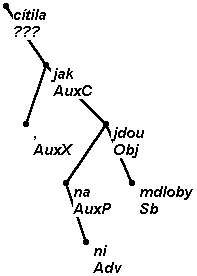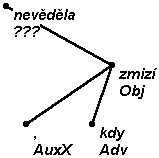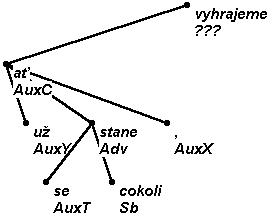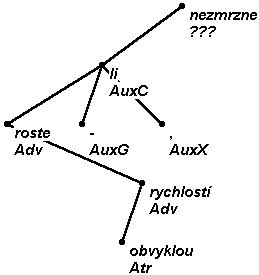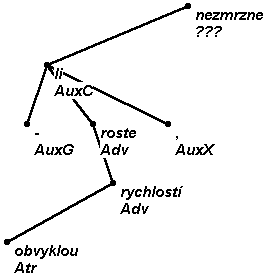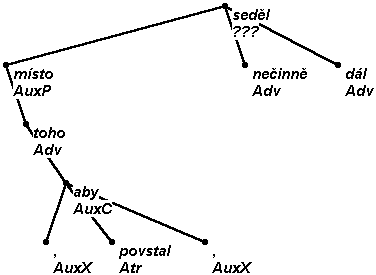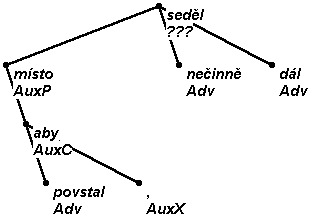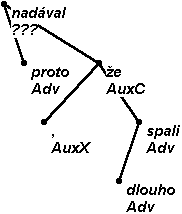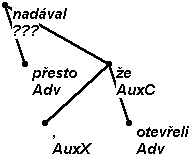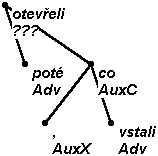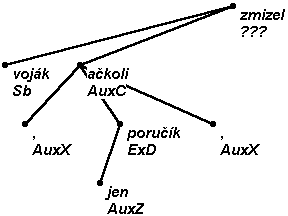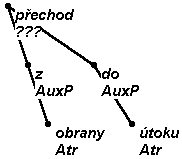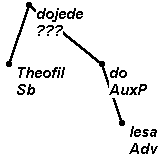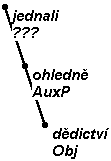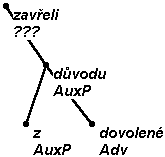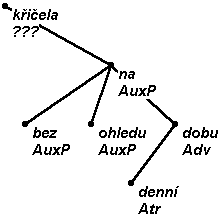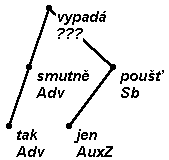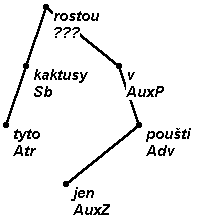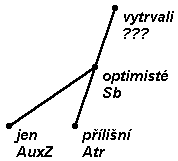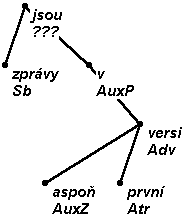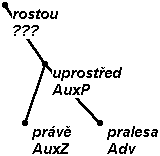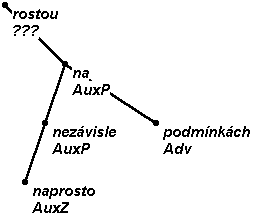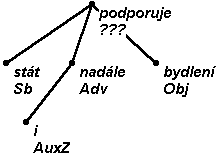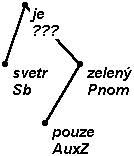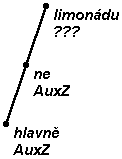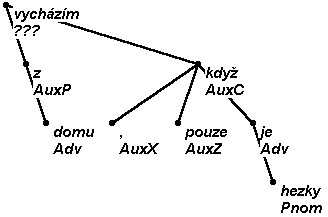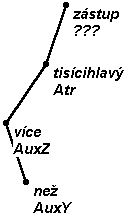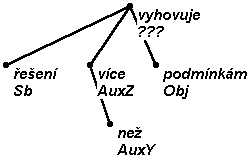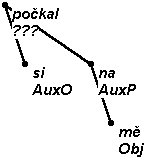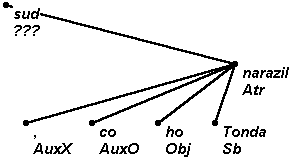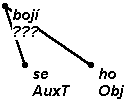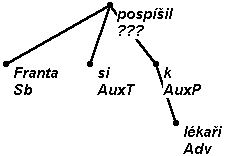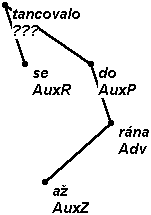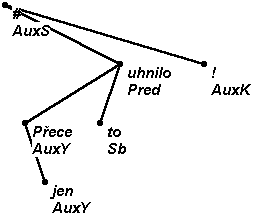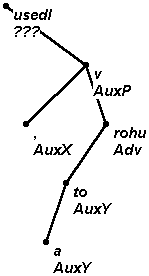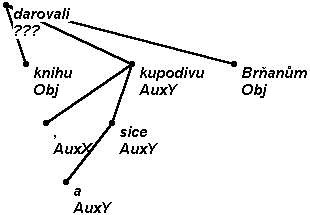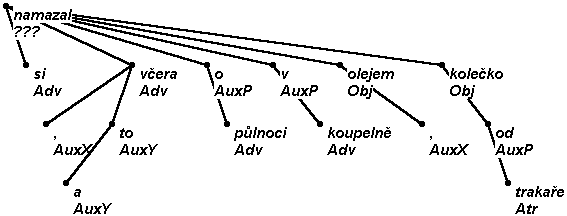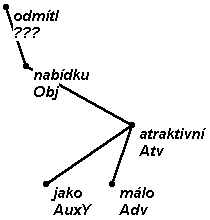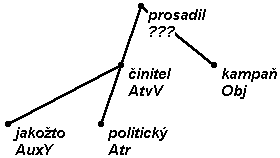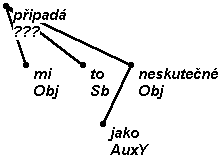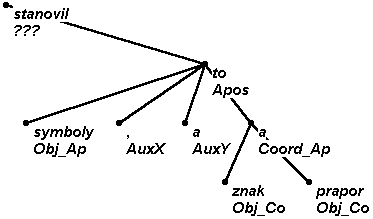In the part Definition of AuxC the information can be found as to where the subordinating conjunctions are to be placed in the tree and which conjunctions belong to this class. Consequently, a list of them has been included. As can be seen, some of the conjunctions consist of two words. The way how and where they are to be suspended in the graph are described in the part Compound (multiple element) subordinating conjunctions. Another idiosyncratic conjunction is represented by the suffix li annexed with the aid of a hyphen, to be dealt with in the part representation of the conjunction -li.
Some problems concearning the connecting (suspending) of subordinated conjunctional clauses will be touched in attachment of subordinate clauses. The reader gets acquainted with the possibility that a conjunction may depend on a preposition, as well as about divided pairs of words proto-že and přesto-že (because of, in spite of). At last, in the part An individual sentence member attached by a subordinating conjunction, it is shown that what can depend on a conjunction (i.e., what has been introduced by it) need not represent a whole subordinate clause, but be a mere independent sentence member (without representing an ellipsis handled with the aid of ExD).
(Subordinate) clauses consist of relative and conjunctional sentences. The predicate of a relative clause depends directly on its head included in the higher sentence, and the relative word obtains its function inside its subordinate clause (ex. (2)). In a conjunctional clause, the conjunction, which is assigned afun AuxC, is placed as dependent on the head word and the predicate of the clause depends on the cojunction. Thus, the latter becomes the technically governing node of the clause (ex. (1)).
There is a number of subordinating conjunctions which we mark as AuxC. They often are ambiguous, being thus able to fulfil other functions as well. E.g., the word co (what/when) obtains AuxC in temporal meaning only (close to the conjunction když (when)), especially when following such referential expressions as poté (after), mezitím, zatím (while), or participating in a "multiple" conjunction jen co (just when).
In spite of the fact that there are also such conjunctions (e.g.aniž (without)) which can function as both subordinating (AuxC) and coordinating (Coord), the great majority of conjunctions belongs to one of the two categories only and must not be confused (for coordinating conjunctions see part Coordinating conjunctions).
A list of subordinating conjunctions AuxC: aby, ač, ačkoli, ačkoliv, aniž, ať, ať už, až, byť, co, dokud, i kdyby, i když, jak, jakkoli, jakkoliv, jakmile, jako, jelikož, jen co, jestli, jestliže, kdežto, kdyby, kdykoli, kdykoliv, když, leda, ledaže, ledva, ledvaže, -li, mezitímco, nechť, než, nežli, pakli, pakliže, pokud, poněvadž, poté co, protože, přestože, sotva, sotvaže, takže, třeba, třebas, třebaže, zatímco, zda, zdali, že
Most of the conjunctions consist of one word only. Nevertheless, there are also two-word conjunctions, which then take two nodes in the tree. To be able to represent them we use the function AuxY. As can be seen from the examples below, we choose one word of the two-word conjunction to take the position of the whole. This will obtain afun AuxC and it will be placed according to the above rules between the word modified by the clause and its predicate. The otgher word belonging to the conjunction will be suspended from this AuxC and marked by the mentioned afun AuxY. (This function is dealt with in the Parts of multi-word constructions, some particles, decayed parenthesis AuxY, where the part Compound subordinating conjunctions is devoted particularly to subordinating conjunctions).
In the following examples the part with afun AuxC is in emphasized:
This conjunction is placed as an independent node, as all conjunctions are. The hyphen preceding it obtains afun AuxG and it will depend directly on the node li (according to Punctuation mark with the conjunction -li (hyphen)). The word preceding the hyphen fulfils its current function in the clause. Therefore, if it represents a predicate (ex. (1)), it will depend on the conjunction, if it plays the role of another sentence member (ex. (2)), it will depend on the node where it belongs according to the rules of annotation.
If the main clause contains a 'referential word' corresponding to the attached clause, it needn t be quite clear on which node this subordinate clause (i.e., technically, the conjunction) should depend. Generally this problem is dealt with in Referring words. Here we shall touch on some problems concerning conjunctions.
If the pronoun to (it) accompanies a subordinate clause having the function Atr (according to the rules, part Referring pronoun to (that)), then the clause (its predicate) depends on to, as shown in the example (1). However, if the pronoun to accompanies a subordinate conjunctional clause (perhaps in a prepositional case, e.g. místo toho instead of it), then this pronoun functions as a referential word and is left out (and only the preposition remains in the clause). Then the subordinate clause (technically, the conjunction) can depend directly on this preposition. Its predicate, of course, obtains such an afun which would be assigned to the pronoun to, if it hadn't been left out. This case is demonstrated in the example (2).
As has been pointed out in the part Referring words with adverbial embedded clauses, adverbial references as well as the adverbial clauses referred to by them are placed side by side (provided the case is not that of referential to) in the tree. This holds for groupings proto, že, přesto, že, poté, co, mezitím, co, zatím, co, ..., if they are written separately in the text; on the other hand, one-word conjunctions which were derived from these collocations (protože - because, přestože - in spite of, mezitímco - in the meantime, zatímco - while,...) are handled as simple conjunctions.
It may happen that a subordinating conjunction doesn t attach a subordinate clause but just an individual sentence member. This often happens with conjunctions jako and než (as, like, than), this problem being described in detail in Phrases of comparison with conjunctions jako (as), než (than). However, this can happen also with other conjunctions. A general criterion that can decide whether the case concerns a real sentence member lies in that the attached member cannot be normally expanded into a clause - nothing can be added, completed, without changing the meaning. If anything could be added, i.e., if in the place following the conjunction a complete clause might originally occur, an ellipsis must be presumed where only some member of the clause remained. This member, therefore, obtains afun ExD since a predicate is missing aa its head.
Real separate sentence members (rather than cases of deletion) attached with the aid of conjunctions (which is why they obtain some current afun, mostly Adv or Atr) can be found in the following examples:
In other cases ExD will be assigned, since an ellipsis in the clause is assumed:
The section dealing with prepositions consists of two parts. The part Representation of prepositions describes how and where the classical prepositions are to be suspended in the tree. Prepositions, however, cannot be limited to the classical ones only - one-word and one-node prepositions. There are also the so-called secondary or pseudo-prepositions, which can consist of more words and take thus more nodes. How these are to be represented can be found in the part Improper prepositions.
Prepositions are generally assigned function AuxP. Their position in the tree is above the noun they introduce. They are placed, therefore, where the noun not having any preposition would be suspended, and the noun introduced will depend on the preposition.
Prepositions AuxP are emphasized:
Improper prepositions are regarded as prepositions and we treat them in a similar way as the classical ones. Their list is enclosed in the supplements in List of secondary prepositions.
If the secondary preposition consists in one word, no difference in representation ensues: it will depend in the same way as a primary preposition would do (see ex. (1)). Secondary prepositions, however, can consist of more words as well. In such cases the last word (node) of the preposition is taken and gets placed, as if it were a primary preposition, above the noun introduced by it. The remaining preceding nodes will depend directly on the last node all side by side. They obtain the same afun AuxP (exx. (2) and (3)). The whole secondary prepositions are emphasized:
Which words can obtain afun AuxZ, under which circumstances this is carried out and how these words behave is accounted for in the part Defining of AuxZ. The part Members modified by means of AuxZ shows where all the AuxZ can depend (what can they emphasize); several trees can be found there to illustrate some particular cases. In Multi-word emphases the case of the construction více než (more than) is dealt with, which under certain circumstances is regarded as emphasizing, and whose representation within a tree-graph is considered.
In a sentence, afun AuxZ is assigned to particles which fulfil the function of emphasizing a sentence member. They can emphasize almost any sentence member.
Only another AuxZ may depend on the node with afun AuxZ (in case one emphasizes the other - see Members modified by means of AuxZ), or AuxY (if a multiple-word emphasizing is the case - see Multi-word emphases).
For our purpose the words that can obtain afun AuxZ are included in a list. Words not contained there cannot be annotated in this way. In preparing this list we have relied on more sources. To Šmilauer's list further words are added, especially those regarded as emphasizing by the Academic Grammar of Czech (AM, 2, pp. 228-238, esp. 235).
The list of potential AuxZ: akorát, alespoň, ani, asi, aspoň, až, celkem, dohromady, dokonce, hlavně, hned, i, jakoby, jedině, jen, jenom, ještě, již, jmenovitě, leda, málem, maximálně, minimálně, nanejvýš, například, ne, nejen, nejenže, nejméně, nejvíce, nikoliv, pak, pouze, právě, prostě, především, přesně, přímo, přinejmenším, rovněž, rovnou, skoro, sotva, taky, téměř, teprve, toliko, třeba, už, vůbec, zase, zejména, zhruba, zrovna, zřejmě, zvláště
As emphasizing in some cases also constructions více než (more than) and méně než (less than) can be regarded - see Multi-word emphases.
The majority of the elements in the list consists of ambiguous words, which means that they can obtain some other afun according to context. As to the parts of speech, the Auxz words are ambiguous mostly with adverbs, but also with other parts of speech. E.g., according to SSČ:
The decision as to which concrete afun (AuxZ or other) to choose on the basis of context is up to the annotator. In the following examples some of the words taken from the list (emphasized) are shown in some of their functions:
In some cases not even a whole sentence suffices for univocal determination of the function. E.g., in the following sentences
The emphasized words can, apart from obtaining function AuxZ, be interpreted as Adv and depend on the verb.
In the tree structure AuxZ depends immediately on the word which is emphasized by it. Examples show emphasizing a simple noun (ex. (1)), a noun in a prepositional construction (ex. (3)), a whole noun phrase (exx. (4) and (5)), secondary prepositions (exx. (6) and (7)), numerals (ex. (8)), verb (ex. (10)), adverb (ex. (11)), adjective (ex. (12)), another emphasizing particle (ex. (13)), individual members of a coordination (ex. (14)) and subordinate clause (ex. (15)).
AuxZ is emphasized.
Emphasizing nouns and numerals: In positions close to a noun or to a numeral (i.e. when not introducing a clause), some words cannot obtain any other afun than AuxZ. A list of such words (a partial list of potential AuxZ) follows: akorát, alespoň (aspoň), asi, celkem, dohromady, i, málem, maximálně, minimálně, nanejvýš, nejméně, nejvíce, právě, přesně, přinejmenším, skoro, taky, téměř, zhruba
Emphasizing improper prepositions: While in emphasizing prepositional cases with "current" prepositions the emphasizing word depends on the noun, the so-called secondary prepositions (see Improper prepositions) themselves can be emphasized.
Emphasizing a verb: AuxZ can (see ex. (10)) sometimes depend on the predicate, too. This case, however, mustn t be mistaken for the occurrence of the so-called particle relating to the contents of the utterance as a whole; this particle also depends on the verb, but it obtains afun AuxY (see Particles pertaining to the whole utterance). The two examples below concern "particle pertaining to utterance" (AuxY, emphasized):
Emphasizing subordinate clauses: With dependent clauses introduced by such compound conjunctions as "i když", "i kdyby" (even when, even if) emphasis is not the case. The word i represents an inseparable part of the conjunction and it obtains afun AuxY (see Compound subordinating conjunctions).
In some cases also such constructions as "více než" a "méně než" (more than, less than) function as emphasis. It happens whenever the author infringes on syntactic relations, when the words more or less defy current treatment described in Phrases of comparison with conjunctions jako (as), než (than). They are, e.g., constructions morphologically equivalent to the example více než tisícový zástup - more than thousand-headed crowd (correctly: větší než tisícový zástup - larger than thousand-headed...).
afun AuxZ is given to více/méně; než (than) becomes dependent on it and obtains afun AuxY (which is done in agreement with the rules on afun AuxY - see Compound emphasizing particles).
afun AuxO are assigned to:
(1) Ethical Dative fulfils the function of linking up with the addressee, i.e. resuming (maintaining) contact (to vám byla zábava; včera jsem ti nemohl usnout; on ti byl celý nesvůj = (approx.): that was an entertainment, I tell you; yesterday I couldn't fall asleep, you know; you see, he was quite beside himself). Such a contacting function can be found with the dative of interest, at times called dative of communicativeness, too (kyselina nám začíná reagovat, běží nám osmá minuta, neparkujte nám na trávě = (approx.): we have the acid starting to react, we have the 8th minute running, we don t want to have you parking on our lawn).
Emotional Dative colours utterances with emotions (to je mi pěkný pořádek, ty nám tu lenošit nebudeš = (approx.) a pretty mess it is, I say; you are not going to idle away your time here, we'll see to it). Distinguishing these types of dative is dealt with in The boundary line between free and 'bound' dative.
In the form of the above mentioned datives also the reflexive particle si can occur. This then obtains afun AuxO (see the rule SI 4 in Reflexive si).
(2) Some words (to it, ono that, co what,..) seem "superfluous" in some sentences. Essentially, they duplicate some other sentence member already present (functioning). This, as a rule, is a matter of emotion or rhythm. In case we find another element in the sentence seemingly fulfilling the function of these words, we denote these words as afun AuxO. This, e.g., happens even if such a word has a position similar to that of subject in a one-member sentence (to prší - what a rain).
Particles with afun AuxO are emphasized:
afun AuxT are assigned to the particles se, si in case the verb without them doesn't exist, as a Reflexivum tantum. This case is described by the rules SE 1 and SI 1 in Reflexive se, si ).
afun AuxR is assigned to the particle se if it represents a reflexive passive according to the rule SE 3 (or, as the case may be, SE 4) in Reflexive se, si).
There are more phenomena for which afun AuxY is used, and they are of different character. In fact, this section in its essence represents a list of different individual instances of application of this function. It is assigned to particles pertaining to the whole sentence (Particles pertaining to the whole utterance), particles introducing a loosely attached member (Particles introducing a loosely attached sentence member), a conjunction as an introducing complement or an object (The conjunction jako introducing complement or object). Also parts of different collocations, particularly of coordinating conjunctions (Particles forming a part of connecting expressions), of subordinating conjunctions (Compound subordinating conjunctions), of apposition expressions (Multi-word apposition expressions) and of emphasizing particles (Compound emphasizing particles) obtain this function. Last but not least, also parts of phrasemes dealt with in Collocations, phraseologisms (phrasemes) (here Parts of phrasemes) are denoted in this way.
Most of the parts of this section contain lists. They are lists of words which occasionally can obtain AuxY. It holds without exception that whatever is not included in these lists cannot be classed with this afun.
The function AuxY is, among others, assigned to particles that pertain to the contents of the whole sentence, i.e., to those traditionally called sentence adverbs. In this respect they differ from the emphasizing particles, which can pertain to individual nouns (noun groups), numerals and adverbs, or, as the case may be, to subordinate clauses (see Emphasizing words AuxZ).
The particles cannot be identified but on the basis of contexts in which they are found. For the most part, as a matter of fact, they are ambiguous, above all with adverbs, or with conjunctions. They differ from adverbs in that they do not represent sentence members and they do not form syntagms together with other words in the sentence. They differ from conjunctions in that they do not have an independent clear-cut connecting function.
The words that can obtain afun AuxY are given by a list. This means that words which fail to appear in the list cannot figure in the role of a particle pertaining to the whole of the utterance.
These words can obtain a bare afun AuxY unless they are graphically separated in the text. In case they are separated, they obtain afun AuxY_Pa, since they represent a parenthesis. The same lists, however, hold for both the functions. The parenthesis of the type AuxY_Pa is described in A 'frozen' parenthesis AuxY_Pa.
A list of potential AuxY which pertain to the whole utterance and which are ambiguous with adverbs: asi, bohudík, bohužel, cožpak, jakoby, jasně, kupodivu, možná, nakonec, naopak, například, nesporně, nicméně, nu, nuže, opravdu, ostatně, patrně, pravděpodobně, prostě, prý, přece jen, rozhodně, samozřejmě, skutečně, snad, stejně, tak, tedy, totiž, určitě, věru, vlastně, však, zřejmě
A list of potential AuxY pertaining to the whole utterance, which are ambiguous with conjunctions: aby, ať, ať už, kdyby, že
In the tree structure the particle having the function AuxY depends on the predicate of the clause in question. If more words belonging together are involved (přece jen (although), ať už (be it), rather than two independent particles - například kupodivu... - for instance, strangely enough), one gets suspended from the other, the higher position taken by the first in the sequence
In the following examples the particles with the function AuxY (emphasized) are placed in the contexts of concrete sentences:
Loosely attached sentence members ( Freely adjoined sentence parts is devoted to them) are, as a rule, introduced by particles a to, a sice, a (i.e., viz., or (else)). The loosely attached sentence members (there is mostly just one, but more of them can be present as well) obtain their current afun, the placement of the particles and of comma can be seen in the examples. Commas depend on the outermost members like parenthetic punctuation (described in the part Bracketing AuxG). The particles which obtain afun AuxY depend on the first member and in case they consist of two nodes, the first node of the particle depends on the second.
The AuxY particles introducing a loosely attached sentence member are emphasized.
The function AuxY is also assigned to the conjunctions jako, jakožto (as) in case the nouns (or adjectives) introduced by these conjunctions play the role of a predicative complement (see Complement introduced by the conjunction jako) or of an object (see Object Obj, ObjAtr, AtrObj, esp. the part Object after copulas and semi-copulas).
To distinguish the meaning of jako as a conjunction (AuxC) from that of jako as a part of a complement (AuxY) Šmilauer recommends a simple test: If it is a complement to be attached, jako can be replaced by jakožto; e.g., in the sentence Kutná Hora byla založena jako horní osada (K.H. was founded as a mining settlement) the function is a complement, rather than a comparison - jakožto can stand in the place of jako, having the function AuxY. Cf. spí jako zabitý (sleeps as a log) - here it is a classical conjunction (expressing comparison), to be suspended in accordance to principles for AuxC. The same that holds for complement does for object, too.
The conjunctions jako, jakožto - AuxY introducing (i.e. a complement referring to an object and displaying grammatical agreement with it) depend in the tree structure on this complement/object (which has AtvV/Obj) as its daughter nodes.
The function AuxY belongs also to particles which figure as parts of expressions introducing coordination, partly as compound classical conjunctions (part Multiple coordinating expressions), partly as some expressions that currently close the coordination (part Non-standard termination of a coordinated list).
A list of compound coordinating conjunctions: (Parts with afun AuxY are emphasized.)
| a proto |
| a přesto |
| proto ale |
| přesto ale |
| a tak |
| a tedy |
| a tudíž |
| a tím |
| ale zato |
| sice ... ale |

| sice ... avšak |
| sice ... nicméně |
| ani ... ani |
| i ... i |
| jednak ... jednak |
| jak ... tak |
| buď ... nebo |
| buď ... anebo |
| buď ... a nebo |
In the case of "separate" expressions (of the type ani ... ani, buď ... anebo, sice ... ale (neither ... nor, either ... or, though ... but), etc.) we regard the second part as the bearer of a connecting relationship. The first component obtains afun AuxY.
The particles with the function AuxY forming a part of the connecting expression depends on the pertinent conjunction in the tree structure (side by side).
A list of current but non-standard closing elements of coordination: The parts with afun AuxY are emphasized

| a tak dále (and so on) |
| a tak podobně (and similarly on) |
| a podobně (and similarly) |
| et cetera (etc.) |
From the coordination conjunction (which is to control the whole coordination) the remaining words will be suspended and they obtain afun AuxY. If there are two such words, the first depends on the second.
Subordinating conjunctions (AuxC) can consist of more elements (see Compound (multiple element) subordinating conjunctions). Mind, however, mistaking them for mere emphasizing a subordinate clause. If a subordinate clause is introduced by pouze když (only if), the conjunction is když while the pouze plays the emphasizing role only (see Members modified by means of AuxZ). On the other hand, the conjunctions contained in the list are inseparable.
A list of compound subordinating conjunctions: AuxY dependent on the second element having afun AuxC are emphasized.
If the expression introducing apposition consists of more elements, it is the last word in the series that becomes the governing node with afun Apos. The remaining members depend on it and obtain afun AuxY. The particle with afun AuxY is emphasized.
Apposition can be introduced by one of the following multi-word expressions:
a sice (that is), a tedy (and thus), a to (that is), jako je (that is, with a form of the verb be), jako například (as for instance), tak třeba (as for instance), to jest (that is), to znamená (that is)Emphasizing particles are usually one-word elements (see Defining of AuxZ). Exceptions are represented by such groups as "více než" a "méně než" (more than, less than) which under certain circumstances (infringement of syntactic rules - see Multi-word emphases) can be represented as two-word emphasizing expressions. The word než then obtains afun AuxY and depends on the second node, which is assigned AuxZ.
All elements participating in various phrasemes obtain afun AuxY. This problem is dealt with in Collocations, phraseologisms (phrasemes).
